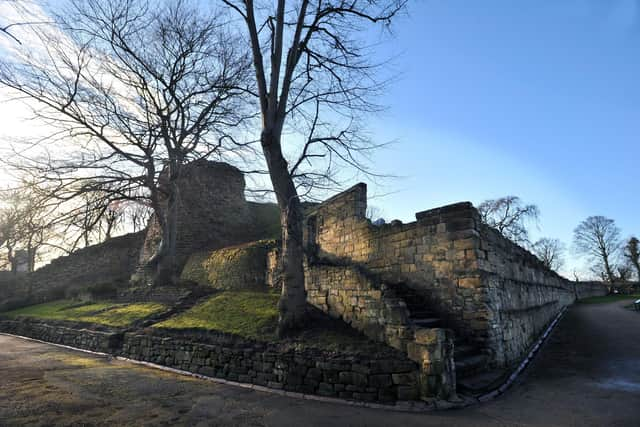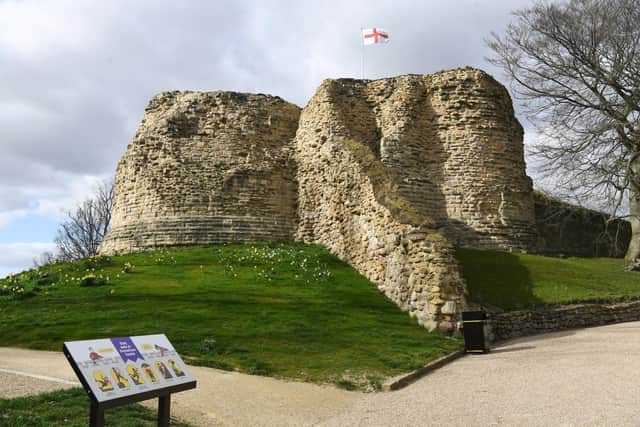The lost dungeon of Pontefract Castle: How visitor is convinced underground cell has been forgotten about for 40 years
and live on Freeview channel 276
Visiting the site as a teenager over 50 years ago, Mr Atkinson has a distinct memory of descending into a prison cell beneath a trapdoor in the eastern part of the bailey. The tiny room underground could only fit around five people inside, and had wooden steps. The guide told him it was where King Richard II was kept before his death, possibly from dehydration and neglect, after being captured as a prisoner in 1400.
Mr Atkinson returned to Pontefract Castle in the 1980s, and remembers seeing the trapdoor again – this time padlocked and inaccessible. Yet following more recent visits, its presence had completely disappeared and the entrance appeared to have been grassed over.
Advertisement
Hide AdAdvertisement
Hide AdCastle staff denied all knowledge of the oubliette, claiming it was more likely to have been the extensive network of medieval cellars and stores or the dungeon where Civil War prisoners left their graffiti – which are both open to the public. Yet Mr Atkinson is convinced they are not talking about the same place and has questioned whether the cell has been infilled or even just forgotten about down the decades.


"I tried to spot it on Google Earth but there was no sign of it. I contacted castle staff who denied that it existed and claimed that I had mistaken it for other underground workings, storerooms etc, in the western part of the bailey. I pointed out to them that I have a highly credible witness and also listed a number of features unique to the oubliette.
"I believe the oubliette became overgrown in the 1980s and during the renovations perhaps a top dressing was applied which buried the trapdoor and
new staff who were employed after this period had no knowledge of it. There must have been a key to the trapdoor somewhere in the castle.
Advertisement
Hide AdAdvertisement
Hide Ad"There must be more witnesses, probably aged over 70, who also visited the dungeon and this is an important historic site built specifically to imprison King Richard II.”


Mr Atkinson, who grew up in Leeds and now lives on the Isle of Man, described the oubliette as ‘very small’ with no openings to other chambers. Its walls were lined with dressed stone, it had wooden steps with a gap between the flight and the wall, a trapdoor that was not near a wall or any other feature, and no graffiti. The only light came from the entrance and it was not wired for electricity at the time.
He contacted local history societies to ask for anyone who remembered descending into the oubliette to come forward, and received a response from Christine Steels, who also believes she has visited it.
“I remember it just as he has described. It’s a very small square opening and you descend down some steep steps. I too think they were wooden. In later years I saw the entrance padlocked. The entrance is only big enough for one person at once. Inside it’s very small, only big enough for maybe 5-6 persons,” Mrs Steels wrote.
Advertisement
Hide AdAdvertisement
Hide Ad“It’s hewn out of the rock; as you turn to go out on your left there is a cleft in the wall. When I went to see it you had a guide and if my memory serves me well we were told it was used to keep King Richard II as a prisoner .
“As you enter through the main castle gates, turn to your left, walk down about halfway (before you come to the remains of the kitchens which are about bottom left hand corner). The little trapdoor to the oubliette is roughly about in the middle of what is the grassy oval section that the footpath goes round; it is quite close to the footpath edge.
"I haven’t been to the castle for a few years now. The last time I visited was during a liquorice festival, and the middle grassy section was being used for the fete. It’s very possible that it’s had more grass planted over the years. It’s a very important part of not only the castle’s history but English history too.”
Wakefield Council, who manage Pontefract Castle, confirmed that staff had no knowledge of an inaccessible dungeon.
Do you remember visiting the ‘oubliette’? Contact [email protected] and we will pass your information to Mr Atkinson.
